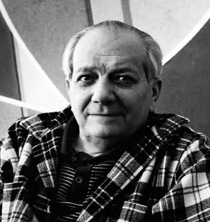Self-taught artist whose work became known as Concrete Art
 |
| Animated Tension (1953): An example of the abstract art of the Italian painter Alberto Magnelli |
Concrete Art is described as abstract art that is entirely free of any basis in observed reality and that has no symbolic meaning. It had strong geometric elements and clear lines and its exponents insisted the form should eschew impressionism and that a painting should have no other meaning than itself.
The movement took its name from the definition of concrete as an adjective rather than a noun, meaning ‘existing in a material or physical form’.
It became Magnelli’s focus after he moved to Paris in 1931. Until then, he had experimented in various genres.
 |
| Alberto Magnelli taught himself to paint while on holiday in rural Tuscany |
Magnelli’s first paintings were landscapes, which he began to produce while on holiday in the Tuscan countryside. His work was good enough for him to submit to the Venice Biennale, as a result of which he made his first sale in 1909.
By 1915, he had moved towards painting in abstract style, having become part of a circle of artists in Florence in which the Futurist Gino Severini was a prominent member and having met Cubists such as Pablo Picasso and Fernand Léger.
After the First World War, in which he did compulsory military service, he continued to paint entirely abstract works but was unhappy that the avant-garde movement in Italy appeared to be supportive of Fascism and returned to painting quiet Tuscan landscapes, and figure studies. These had echoes of the Metaphysical style of Italian artists Giorgio de Chirico and Carlo Carrà.
 |
| Some of Magnelli's works, such as The Readers (1931), had echoes of the Metaphysical movement in Italian art |
Following the invasion of France by the Nazis, during the Second World War, Magnelli and his future wife, Susi Gerson, went to live in Grasse with several other artists. Some of the group, including Gerson, were Jewish so they were forced to hide. Because conventional art materials were in short supply, Magnelli created textural geometric collages using materials such as corrugated cardboard, emery cloth, music paper, stitched wire, and metal plates.
He also made paintings on schoolchildren’s wood-framed slate boards. Many of these were geometric compositions constructed from flat areas of colour and inscribed white lines, while others were inscriptions of purely geometric lines. It was the beginning of Concrete Art. He again exhibited at the Venice Biennale and major galleries organised retrospectives of his work.
Following the Second World War, Magnelli returned to Paris which was to be his home for the rest of his life. He died there in 1971.
| The Giubbe Rosse has been serving customers in Florence's Piazza della Repubblica since 1896 |
Florentine artists of Magnelli’s era used to meet at the Caffè Giubbe Rosse in Piazza della Repubblica, which took its name from the red jackets - giubbe rosse - the waiters still wear to this day. When opened in 1896, it was called Fratelli Reininghaus after the German brothers who founded it. The writer and poet Alberto Viviani called the Giubbe Rosse a "fucina di sogni e di passioni - a forge of dreams and passions".
| The central square in Sansepolcro, Tuscany |
Sansepolcro, which is the birthplace of Piero della Francesca, is a town of 16,000 inhabitants situated about 110km (68 miles) east of Florence and 38km (24 miles) northeast of Arezzo. The historic centre is entirely surrounded with fortified walls, built in the early part of the 16th century. The centre of the town is the Piazza Torre di Berta, named after the 13th-century tower of the same name, off which can be found the impressive Palazzi Pichi and Giovagnoli and the 14th-century cathedral, dedicated to St John the Evangelist.
More reading:
Giorgio di Chirico, founder of the Scuola Metafisica
Carlo Carrà and the Futurist movement
Giorgio Morandi - master of still life
Also on this day:
1586: The birth of 'lost' composer Claudio Saracini
1878: The birth of career burglar and cult figure Gino Meneghetti
Home